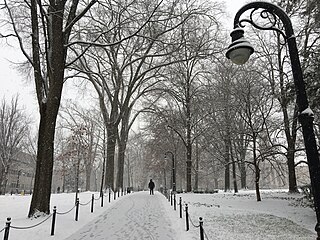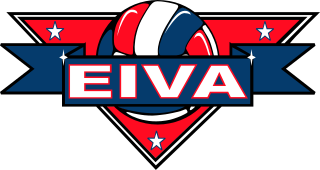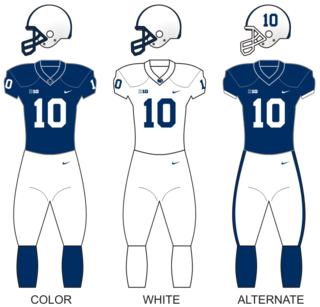
State College is a home rule municipality in Centre County, Pennsylvania, United States. It is a college town, dominated economically, culturally, and demographically by the presence of the University Park campus of Penn State University.

The Palestra, often called the Cathedral of College Basketball, is a historic arena and the home gym of the Penn Quakers men's and women's basketball teams, volleyball teams, wrestling team, and Philadelphia Big 5 basketball. Located at 235 South 33rd St. in Philadelphia, Pennsylvania on the campus of the University of Pennsylvania, near Franklin Field in the University City section of Philadelphia, it opened on January 1, 1927. The Palestra has been called "the most important building in the history of college basketball" and "changed the entire history of the sport for which it was built".

Beaver Stadium is an outdoor college football stadium on the campus of Pennsylvania State University in Penn State University Park. It has been home to the Penn State Nittany Lions of the Big Ten Conference since 1960, though some parts of the stadium date back to 1909. It was also the site of university commencements until 1984. The stadium, as well as its predecessors, is named after James A. Beaver (1837–1914), a governor of Pennsylvania (1887–91), president of the university's board of trustees, and native of nearby Millerstown. Officially, the stadium is part of the municipality known as College Township, Pennsylvania, although it has a University Park address.

The Pennsylvania State University is a public state-related land-grant research university with campuses and facilities throughout Pennsylvania. Founded in 1855 as Farmers' High School of Pennsylvania, in 1863, Penn State was named the state's first land-grant university. Its primary campus, known as Penn State University Park, is located in State College and College Township in Pennsylvania.

University Park, also referred to as Penn State University Park, is the name given to the Pennsylvania State University's main campus located in both State College and College Township, Pennsylvania. The campus post office was designated "University Park, Pennsylvania" in 1953 by Penn State president Milton Eisenhower, after what was then Pennsylvania State College was upgraded to university status.

Mount Nittany is the common name for Nittany Mountain, a prominent geographic feature in Centre County, Pennsylvania, United States. The mount is not a mountain but is part of a ridge that separates Nittany Valley from Penns Valley, with the enclosed Sugar Valley between them. On USGS topographic maps, Nittany Mount is generally too small to be considered a mountain and is shown as the lower ridge line that runs below Big Mountain on the west and Big Kettle Mountain on the east side, coming together to form a single ridge line at the southern terminus. This nomenclature is not always consistently applied to the same geologic formation, and there is a shorter Nittany Mountain ridge shown above the Sugar Valley as well.

Medlar Field at Lubrano Park is a 5,570-seat baseball stadium in University Park, Pennsylvania, that hosted its first regular season baseball game on June 20, 2006, when the State College Spikes lost to the Williamsport Crosscutters, 5–3. The Penn State Nittany Lions college baseball team began play at the ballpark in 2007.

Penn State DuBois is a commonwealth campus of the Pennsylvania State University and it is located in DuBois, Pennsylvania.

Penn State Schuylkill is a Commonwealth Campus of the Pennsylvania State University in Schuylkill Haven, Pennsylvania.

The Eastern Intercollegiate Volleyball Association (EIVA) is a college athletic conference whose member schools compete in men's volleyball. Its member institutions are located in the Northeast United States.

The Penn State Nittany Lions team represents the Pennsylvania State University in college football. The Nittany Lions compete in the NCAA Division I Football Bowl Subdivision as a member of the Big Ten Conference, which they joined in 1993 after playing as an Independent from 1892 to 1992.

Nittany Valley is an eroded anticlinal valley located in Centre County, Pennsylvania. It is separated from the Bald Eagle Valley by Bald Eagle Mountain and from Penns Valley by Mount Nittany. The valley is closed to the north by a high plateau that joins these two mountain ridges, but is open to the south at the southern terminus of Mount Nittany. The valley drains to Bald Eagle Creek through water gaps in Bald Eagle Mountain formed by Spring Creek and Fishing Creek, along with smaller streams running through Curtain Gap and Howard Gap. The northwest side of the valley between the Bald Eagle Mountain ridge and the lower Sand Ridge is also known as the Little Nittany Valley.

The 1907 Penn State Nittany Lions football team was an American football team that represented Pennsylvania State College—now known as Pennsylvania State University–as an independent during the 1907 college football season. The team was coached by Tom Fennell and played its home games on Beaver Field in State College, Pennsylvania. This was the first year that Penn State had adopted the Nittany Lion as its official mascot.

Robert Cook Folwell Jr. was an American football player and coach. He served as the head coach at Lafayette College (1909–1911), Washington & Jefferson College (1912–1915), the University of Pennsylvania (1916–1919), and the United States Naval Academy (1920–1924), compiling a career college football record of 106–29–9. Folwell then moved to the professional ranks, coaching the New York Giants of the National Football League (NFL) in 1925, the Philadelphia Quakers of the American Football League in 1926, and the Atlantic City Roses of the Eastern League of Professional Football in 1927.

The Nittany Lion Shrine is a large mountain lion sculpture carved by Heinz Warneke located at the University Park campus of Pennsylvania State University.
The Penn State Ice Pavilion was a 1,350-seat ice arena on the campus of The Pennsylvania State University located in University Park, Pennsylvania, United States. The ice arena included an NHL regulation sized 200' x 85' ice sheet as well as a 45' x 55' studio ice sheet.

Robert Craig Bolden, Jr. is a former American football quarterback. After attending St. Mary's Preparatory School in Orchard Lake, Michigan, he played college football for the Penn State Nittany Lions from 2010 to 2011. He transferred to Louisiana State University and was a member of the LSU football team from 2012 to 2013. Bolden transferred again and finished his college football career as a member of the 2014 Eastern Michigan Eagles football team.
The 1999–2000 Princeton Tigers men's basketball team represented the Princeton University in intercollegiate college basketball during the 1999–2000 NCAA Division I men's basketball season. The head coach was Bill Carmody and the team co-captains were Mason Rocca and Chris Young. The team played its home games in the Jadwin Gymnasium on the University campus in Princeton, New Jersey, and was the runner-up of the Ivy League. The team earned an invitation to the 32-team 2000 National Invitation Tournament.
The Penn State Nittany Lions women's lacrosse team is an NCAA Division I college lacrosse team representing Pennsylvania State University as part of the Big Ten Conference. They play their home games at Panzer Stadium in State College, Pennsylvania.

















